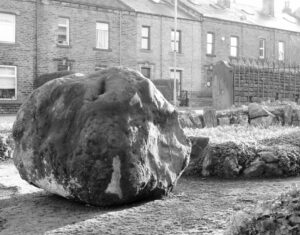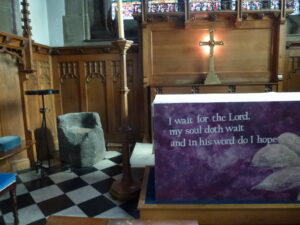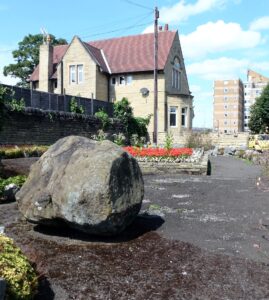Kai Roberts reports on a stone and a borrowed story of boggart behaviour in West Yorkshire
 Ellen Royd, Elland, and its ‘boggart chair’ in 2001 (John Billingsley)
Ellen Royd, Elland, and its ‘boggart chair’ in 2001 (John Billingsley)
In June last year, Calderdale Council in West Yorkshire unceremoniously deposited an incongruous gritstone boulder in the memorial garden of Jepson Lane in Elland. Doubtless many casual observers will have been surprised by its appearance and preservation — as evidently were the contractors, who treated it with a lack of care sufficient to damage the stone in transit. However, students of local folklore will recognise the boulder as that known as the ‘Boggart Chair’, which previously resided on the lawn of Ellen Royd, a Victorian mansion house on Westgate. Its relocation was prompted by Calderdale Council’s recent decision to sell the premises, which it had owned since 1926 and variously used to house a library, a museum and, most recently, a health clinic.
 The stone at its new location in Jepson Lane, Elland (Kai Roberts)
The stone at its new location in Jepson Lane, Elland (Kai Roberts)
A Halifax Evening Courier article from 1977 relates its legend: “In the 17th Century, because of local rumours of ghostly visitation, Ellen Royd was dubbed Boggart House and a stone in the garden, known as the Boggart Chair, was said to have been worn smooth by a ghost”, supposedly as it sat upon the stone awaiting an opportunity to enter the house. The article continues, “But the rumours were scotched when it was apparently discovered that the stone was part of a broken font from Luddenden Church”. This tale was repeated in 1987, in A History of Elland by Albert Rinder, founder of the Greater Elland Historical Society, which doubtless gave it further credence as an authentic local legend.
Yet curiously this story is identical to one told about a house further up the Calder Valley near Midgley, also known as Ellen Royd. The history of this house was detailed, with extensive reference to deeds and wills, in the 1928 Transactions of the Halifax Antiquarian Society, noting that it was originally built in the 16th Century. It was known as Boggart House by 1555 and although substantially rebuilt over the centuries, this makes its provenance considerably older than Elland’s Ellen Royd, which dates entirely from the 19th Century. An inspection of the deeds of this building shows that the site was vacant until the local factory magnate Joseph Smithies acquired the plot in 1878.

The ‘boggart chair’ from Midgley, identified as the font from the old church at Luddenden; now replaced in the chancel of the new Victorian church (John Billingsley)
This would appear to confirm that the Midgley legend substantially pre-dates its Elland analogue. The assertion that the Boggart Chair was in fact part of a broken font, carried (along with a holy water stoup) from Luddenden Church following its depredation by zealous Parliamentarians during the English Civil Wars, also better fits the Midgley context, as Luddenden is considerably closer to Midgley than it is to Elland. Moreover, a broken font bears a greater resemblance to a ‘chair’ than the lumpen boulder at Elland; according to Midgley lore, the font was later restored to the church at Luddenden and indeed can be seen beside the altar there today.
The matter is settled by the fact that the history of Elland’s Ellen Royd, as given by the Evening Courier and Albert Rinder, has similarly been transposed from the Halifax Antiquarian Society’s paper on the Midgely site. This suggests that the confusion originally occurred in print rather than local oral tradition — although whether by accident or design it is difficult to say. Certainly no mention of the Boggart Chair is to be found in any reference to Elland’s Ellen Royd prior to 1977 and significantly the story is not recorded in Lucy Hamerton’s 1901 Olde Eland, which relates several other folk traditions connected with the Westgate area.
Yet this still leaves a mystery: if the stone formerly at Elland was not originally connected with a boggart tradition, what was its original purpose? It was clearly deliberately preserved, as it was positioned on an island of flagstones in the middle of the lawn, and it’s existence is recalled in 1945 and 1958 by individuals who were the children of its live-in caretakers. Neither, however, remember any tradition connected to the stone. Whatever else it is, the stone’s function does not appear to be of any great antiquity, as inspection reveals a number of pieces of rusted iron set into the rock, which at some point have been sheared off. One possibility is that it’s a relic from Elland Museum (which shared Ellen Royd with a library from 1931-1960) whose purpose has been long forgotten.
Whatever its provenance, nobody can dispute that the Elland stone is today fixed as the ‘Boggart Chair’ in the local psyche: Calderdale Council’s representatives were aware of the stone’s significance when they elected to sell Ellen Royd and Greater Elland Historical Society lobbied to guarantee its preservation. This is a fine example of the relationship between printed sources and oral tradition, which is often overlooked by folklorists craving a non-existent ideal of ‘authenticity’. Even if the transposition was a deliberate instance of ‘folklorismus’ (or ‘fakelore’) in order to lend interest to the town, it may be that this is exactly how many older migratory legends passed from place to place, and the story’s persistence amongst Elland’s residents today only demonstrates the truth of Venetia Newell’s adage that “One age’s folklorismus is the next age’s folklore”.

References
Bennett, Paul (2001) The Old Stones of Elmet, p72
Billingsley, John (2007) Folk Tales from Calderdale Vol. 1, p71, 73
Hamerton, Lucy (1901), Olde Eland, p103-106
Newell, Venetia J. (1987) ‘The Adaptation of Folklore and Tradition’. Folklore 98: 131-152
Rinder, Albert (1987) A History of Elland, p65-66
Sutcliffe, T. (1928) ‘A Tour In Midgley: Ellen Royde’, Trans. Halifax Antiq. Soc. 1928:117-123
Unknown (1977) ‘And now for yet another ghost story’, Halifax Evening Courier, 14th July 1977
Published in NE137 (Spring 2014), pp.21-23